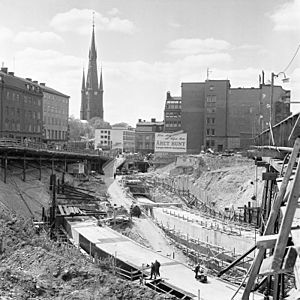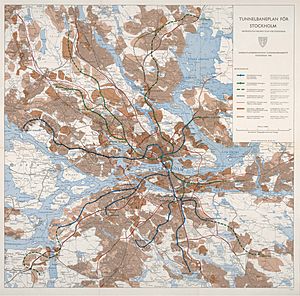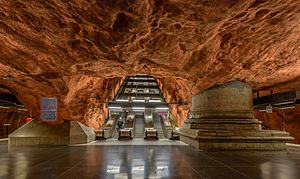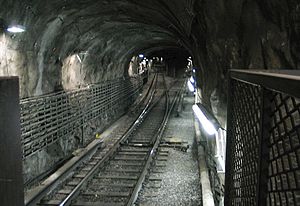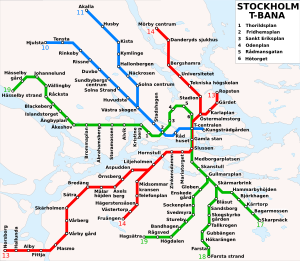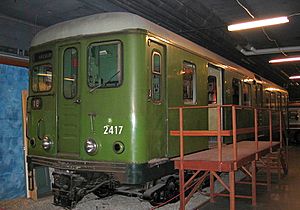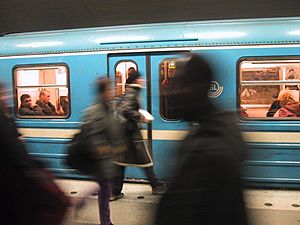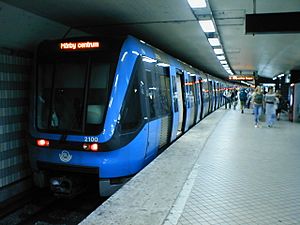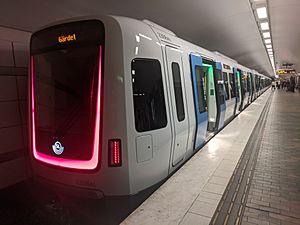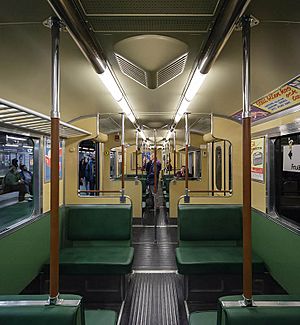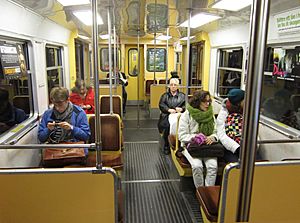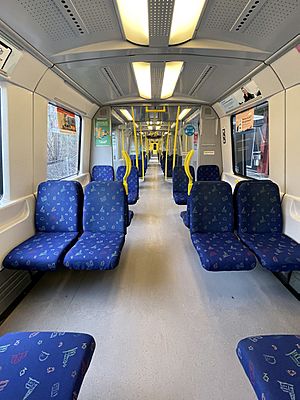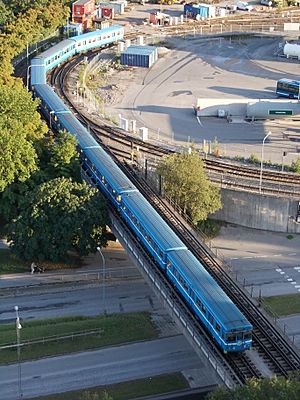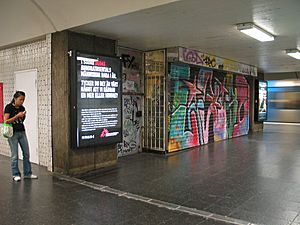Stockholm Metro facts for kids
Quick facts for kids Stockholm Metro |
|
|---|---|
 C20 at Hotorget 2018-03-15.jpg |
|
| Info | |
| Owner | AB Storstockholms Lokaltrafik |
| Locale | Stockholm, Sweden |
| Transit type | Rapid transit |
| Number of lines | 7 |
| Number of stations | 100 |
| Daily ridership | 1.2 million (weekday, 2017) |
| Operation | |
| Began operation | 30 September 1933 (as premetro) 1 October 1950 (as metro) |
| Operator(s) | MTR |
| Train length | 140 metres (459 ft 4 in) |
| Technical | |
| System length | 105.7 km (65.7 mi) |
| Track gauge | 1,435 mm (4 ft 8 1⁄2 in) standard gauge |
| Electrification | 650–750 V DC third rail |
| Top speed | 80 km/h (50 mph) |
The Stockholm Metro (called Stockholms tunnelbana in Swedish) is a fast train system in Stockholm, Sweden. It helps people travel quickly around the city. The first line opened in 1950. Today, the metro has 100 stations. About half of these stations are underground, and the other half are above ground.
The metro system has three main colored lines: Green, Red, and Blue. These lines create seven different routes. All three lines and their routes meet at T-Centralen station. This makes it a very central system. You can also change lines at Fridhemsplan, Slussen, and Gamla stan stations.
To ride the metro, you need a ticket. You can buy tickets in advance at small shops, online, or from machines at stations. You can also buy tickets at the station booths. Another easy way to pay is by using a contactless payment card like Visa or Mastercard.
In 2017, the Stockholm Metro carried 353 million passengers. This means about 1.2 million people rode the metro on a normal weekday! The entire system is about 105.7 kilometers (65.7 miles) long. It is owned by the Stockholm County Council through a company called Storstockholms Lokaltrafik (SL). The trains are operated by MTR.
The Stockholm Metro is famous for its amazing art. It's often called 'the world’s longest art gallery'. More than 90 of its 100 stations are decorated. You can see sculptures, paintings, mosaics, and other artworks by over 150 different artists.
Contents
History of the Stockholm Metro
The idea to build a metro system in Stockholm was approved in 1941. Before the metro officially opened, some parts of the system were built for trams. These trams ran on tracks that were later used by the metro. For example, the oldest tunnel, from Slussen to Skanstull, opened in 1933 for trams.
The first part of the metro officially opened on October 1, 1950. This section went from Slussen to Hökarängen. In 1951, another line opened from Slussen to Stureby. Then, in 1952, a second system started from Hötorget to the western suburbs.
In 1957, these different parts were connected. They joined up at Central station (at T-Centralen) and the Old Town (at Gamla stan metro station). This connection created the Green Line. The Green Line was then extended bit by bit until 1960.
The Red Line opened in 1964. It started from T-Centralen and went to areas in the southwest. This line was also extended over time, reaching Mörby centrum in 1978. The third and final system, the Blue Line, opened in 1975. It has two lines that go northwest from the city center. Newer parts of the metro, like the Blue Line, have more tunnels. This is because building rules became stricter over the years. The newest station, Skarpnäck, opened in 1994.
Metro Network and Stations
How Many Stations Are There?
The Stockholm Metro has 100 stations that are currently in use. As mentioned, 47 of these are underground. One station, Kymlinge, was built but never opened to the public. Another station, Bagarmossen, was replaced with a new underground station.
The metro stations are famous for their unique art. Many stations, especially on the Blue Line, show the natural rock of the tunnels. This rock is often part of the station's design. For example, at Rissne, there's a long painting that tells the story of human history.
Understanding the Metro Lines
The metro lines are known by their colors: Green, Red, and Blue. These names started being used in the late 1970s. The "blue line" trains used to be painted blue, and the "Green line" trains were green. The "Red line" trains were never red, but the color red was chosen for maps to make it easy to tell the lines apart.
- The Green Line (officially called Tunnelbana 1) has three routes and 49 stations. Most of its stations are above ground. It is about 41.256 kilometers (25.6 miles) long. This line opened in 1950 and carries many passengers each day.
- The Red Line (Tunnelbana 2) has two routes and 36 stations. Many of its stations are underground. It is about 41.238 kilometers (25.6 miles) long, almost the same length as the Green Line. It opened in 1964.
- The Blue Line (Tunnelbana 3) has two routes and 20 stations. Almost all of its stations are underground. It is about 25.516 kilometers (15.8 miles) long. This line opened in 1975.
Trains usually run from 5:00 AM to 1:00 AM. On Fridays and Saturdays, they run all night. During the day, trains come every 10 minutes on all lines. In early mornings and late evenings, they come every 15 minutes. At night, they come every 30 minutes. During busy times, trains run more often, sometimes every 2-3 minutes in the city center.
The metro has four main places where you can change between lines: T-Centralen, Slussen, Gamla Stan, and Fridhemsplan. There isn't a circular line like in some other cities. Most metro stations are in the suburbs, but the whole system connects through T-Centralen.
| Line | Route | Travel time |
Length | Stations (in "innerstan") |
|---|---|---|---|---|
| 10 | Kungsträdgården – Hjulsta | 23 min | 15.1 km (9.4 mi) | 14, (5) |
| 11 | Kungsträdgården – Akalla | 22 min | 15.6 km (9.7 mi) | 12, (5) |
| 13 | Norsborg – Ropsten | 44 min | 26.6 km (16.5 mi) | 25, (10) |
| 14 | Fruängen – Mörby centrum | 33 min | 19.5 km (12.1 mi) | 19, (9) |
| 17 | Skarpnäck – Åkeshov | 43 min | 19.6 km (12.2 mi) | 24, (12) |
| 18 | Farsta strand – Alvik | 37 min | 18.4 km (11.4 mi) | 23, (12) |
| 19 | Hagsätra – Hässelby strand | 55 min | 28.6 km (17.8 mi) | 35, (12) |
| Entire metro network | 108 km (67 mi) | 100, (25) | ||
There is a special track that connects the metro to the main railway network. This is used to bring new trains to the metro system. When trains use this connection, they are pulled by other locomotives. This is because the metro's electricity system is different from the main railway.
Metro Network Map
Metro Technology and Trains
Types of Metro Trains
The Stockholm Metro uses three main types of train cars. These are the newer C20 and C30 trains, and the older Cx trains (which include types C1 to C15). A typical metro train is made of several cars joined together. For example, a C20 train usually has six or nine cars. A C30 train has eight cars. An older Cx train might have six or eight cars.
A full-length train is about 140 meters (460 feet) long. It can carry about 1,250 passengers. Around 290 to 380 of these passengers can sit down. The Blue Line and parts of the Red Line have longer platforms. This allows them to use trains with more cars.
There are 271 C20 trains, about 250 Cx trains, and 96 C30 trains. The Green Line mostly uses C20 trains. The Blue Line uses C20 trains most of the time. The Red Line uses C20 and C30 trains. Sometimes, during busy hours, you might still see older Cx trains. Only the C14 type of Cx trains are still in use, mainly on the Blue Line.
All metro trains are kept at special depots (storage and maintenance areas). These depots are located at Hammarby, Högdalen, Vällingby, Norsborg, Nyboda, and Rissne.
The way metro cars are named comes from old tram names. "C" means it's a metro car.
Older Train Models
Many older train models have been used in the past. Some of these include:
| Class | Introduced | Withdrawn | Notes |
|---|---|---|---|
| C1 | 1950 | 1984 | Some were rebuilt into C2 and C3 |
| C2 | 1950 | 1999 | The most common type made |
| C3 | 1957 | 1999 | Could only run in the middle of trains |
| C4 | 1960 | 2003 | First with a driver's cab at only one end |
| C5 | 1963 | 1996 | Called "Silverpilen" (Silver Arrow), had unpainted aluminum outside |
| C6 | 1970 | 2023 | First with a modern driver's cabin |
| C7 | 1972 | 2004 | Test cars |
| C8/C8H | 1974 | 2004 | Four were rebuilt for another railway line |
| C9 | 1976 | 2009 | |
| C12 | 1977 | 2001 | Built using older technology |
| C13/C13H | 1982 | 2003 | Some were rebuilt into C13H |
| C14z | 1987 | 1999 | Test cars for new technology |
| C15 | 1985 | 2023 |
Cx Trains
The name Cx refers to all the older train types from C1 to C15. Today, only the C14 trains are still in use. These cars are about 17.3 to 17.6 meters (56 to 58 feet) long. They are about 2.8 meters (9 feet) wide and weigh 29 metric tons. Each C14 car can seat 48 passengers and hold about 108 to 110 standing passengers. C14 trains were built in the 1980s.
C20 Trains
The C20 train car is made of two connected parts. It is about 46.5 meters (152 feet) long, 2.9 meters (9.5 feet) wide, and 3.8 meters (12.5 feet) high. It weighs 67 tons. Each C20 car can seat 126 passengers and hold 288 standing passengers. Usually, three C20 units make up one train. These trains were built between 1997 and 2004. They started service in 1998.
There is also a special test C20F car. It is lighter and has more space inside. It also has air-conditioning for passengers. Most regular C20 trains only have air-conditioning for the driver's area.
C30 Trains
The C30 is a newer type of train. It started being used on the Red Line in August 2020. These trains are made of four cars that are always connected. Two of these four-car units make up a full train. The C30 trains have fewer seats but more standing room. They are the first Stockholm metro trains to have air-conditioning for both passengers and drivers. These new trains cost about 5 billion Swedish kronor.
How the Metro Works Safely
The Stockholm Metro runs on electricity. It gets power from a third rail. The voltage is 650 volts DC on some lines and 750 volts DC on others. In Sweden, cars drive on the right side of the road, but metro trains drive on the left side, just like other trains in Sweden. This is because when the metro opened, cars in Sweden also drove on the left.
The maximum speed for trains is 80 kilometers per hour (50 mph) on the Red and Blue Lines. On the Green Line, the maximum speed is 70 kilometers per hour (43 mph). The Green Line has tighter curves, which is why trains run a bit slower there.
The metro uses a special safety system. This system constantly sends information to the train. It checks the train's speed. If a train goes too fast, the system automatically applies the brakes. The driver sees the speed limit on a display in the cabin. This system helps trains run close to each other safely and prevents crashes.
Some parts of the metro also use automatic train operation (ATO). This system helps the driver by driving the train automatically. However, the driver still opens and closes the doors and starts the train. ATO is currently used on the Green Line.
Graffiti on the Metro
Since the 1980s, the Stockholm Metro has had problems with graffiti. In the past, trains with graffiti might stay in service for weeks. Graffiti at stations could remain for months. But now, trains with graffiti are taken out of service right away. Graffiti at stations is cleaned up quickly, usually within a few days. Cleaning up graffiti and fixing damage costs about 100 million Swedish kronor each year.
To fight graffiti, the Stockholm Transit System (SL) started hiring private security companies. The police also have a special team to deal with graffiti.
Future Plans for the Metro
There are exciting plans for new metro extensions! In 2013, agreements were made to build several new sections. Planning started in 2016, and the first new parts are expected to open in the mid-2020s. In 2017, another agreement was reached for even more public transport projects, including a fifth metro line. These will be the first new metro extensions in 40 years. They will add 18 new stations, bringing the total to 118 stations.
Here are some of the new constructions planned:
- The Blue Line will be extended south from Kungsträdgården. It will have a new station at Sofia. After Sofia, the line will split. One part will go to Nacka (with three new stations). The other part will take over the current Green Line branch to Hagsätra. This means the surface stations at Globen and Enskede gård will close. A new underground station at Slakthusområdet will replace them. This change will allow more trains to run on the Green Line branches.
- The Blue Line will also be extended northwest from Akalla to Barkarby railway station. This new section will pass through Barkarbystaden, a new area being built.
- The Green Line will be extended from Odenplan. It will go through new areas like Hagastaden and Södra Hagalund, ending in Arenastaden (near the Friends Arena and Westfield Mall of Scandinavia). This part is expected to be finished by 2028.
- A brand new line will be built between Fridhemsplan and Älvsjö. It will pass through Liljeholmen, Årstaberg, Årstafältet, and Östberga.
See also
 In Spanish: Metro de Estocolmo para niños
In Spanish: Metro de Estocolmo para niños
- List of metro systems
- Malmö Metro


